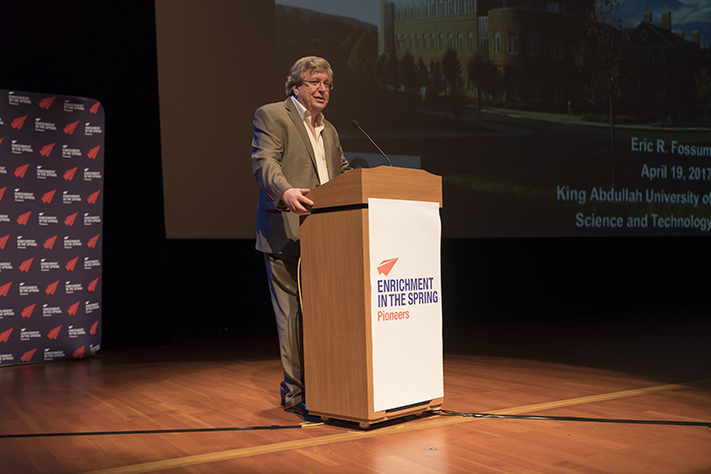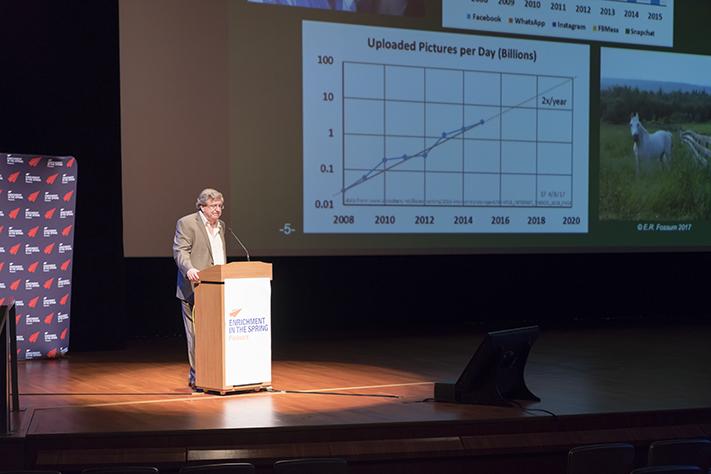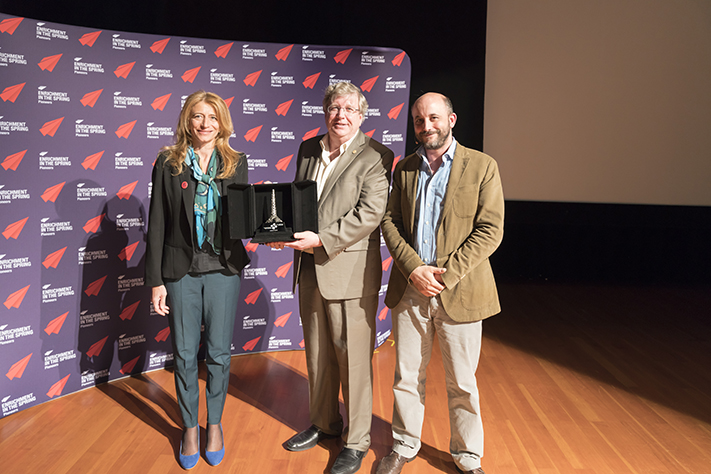How to be a successful scientist-entrepreneur

Dr. Eric Fossum, a professor at Dartmouth and the inventor of the complementary metal-oxide semiconductor (CMOS) active pixel image sensor used in cameras worldwide, speaks during a 2017 Enrichment in the Spring Program lecture on campus.
Some scientists are primarily interested in basic discovery, while some are satisfied with seeing the application of their lab research many years later. Certain entrepreneurial scientists, however, are eager to see their technology or inventions out in the marketplace as quickly as possible.
“The way to make that happen most effectively is through entrepreneurial thinking,” said Dr. Eric Fossum, a professor at the Thayer School of Engineering at Dartmouth and director of the school’s Ph.D. Innovation Program .
Fossum, a U.S. National Inventors Hall of Fame inductee, was featured in the KAUST 2017 Enrichment in the Spring Program. He's best known for his invention of the complementary metal-oxide semiconductor (CMOS) active pixel image sensor, which is used in billions of cameras worldwide. CMOS technology is ubiquitous and is used in webcams, drones, medical imaging devices and many other applications.
Necessity as the mother of invention

After completing his Ph.D. at Yale in 1984 and becoming an electrical engineering faculty member at Columbia University, Fossum was recruited to the NASA Jet Propulsion Laboratory (JPL) at Caltech, where he managed JPL’s image sensor research unit. His main task was to develop lighter and less energy-hungry cameras for use on NASA’s spacecrafts.
“The cameras that they were using back in those days were really large, like the size of a refrigerator,” Fossum explained.
The reason the onboard camera systems were so large is that they operated with a particular type of image sensor called the charge-coupled device (CCD). The electronics required to make them work made the cameras bulky. Fossum and his team at JPL had to come up with a new image sensor technology that would work as well as the existing technology to allow for the miniaturizing of cameras used on spacecrafts.
“It had to work well or better, and that was when the CMOS image sensor came to be,” said Fossum.
It soon became apparent that the small size, low power dissipation and energy efficiency of these new technology sensors would be useful in many applications. Chief among these were portable applications where users would require something small, compact and long-lasting in terms of energy consumption.
“I didn’t expect that my CMOS sensor technology invention would launch a whole selfie and selfie sticks movement,” said Fossum. The popularity of cat videos was another unforeseen result.
After being somewhat frustrated with the slow pace of action after presenting his new technology to various electronics companies, he created the Photobit Corporation to commercialize the technology in 1995. After a few years of development, he sold the company in 2001. Around that time, cellphone camera applications came along, which made CMOS sensor technology very compelling on the marketplace.
“A lot of companies started pouring R&D funds, and thousands of engineers around the world worked on improving the technology, bringing it to where it is now,” Fossum noted.
When asked if he now regrets selling Photobit just as the wave of camera phones gained momentum, Fossum said the timing was right because, as a small company, Photobit was going to face some stiff and well-funded competition. The two options were either to raise vast sums of capital or to sell to an electronics company with the resources to take the technology to the next level.

As basic R&D corporate budgets are shrinking, it has become the norm for big corporations to acquire smaller startups developing market-ready innovative technology. Over the past 15 to 20 years, universities have filled the gap by playing an important role as incubators of future technologies. This means the technology has to be compelling and bring value to the market.
“Usually for a new technology to really take hold and displace an incumbent technology, it has to be better in a compelling way—not just like 20 percent better or something like that. It has to be really compelling,” said Fossum. “The CMOS image sensor was a success because the value proposition wasn’t just a little better. The tech was very compelling."
According to Fossum, scientists can’t simply assume that they can successfully present new technology and get funding as “that often doesn’t happen. You have to do it yourself and prove that it can really be a product. You must take that extra step of translating it from an invention into a real product that’s usable," he noted.
“Our role actually in a university, in my opinion, is to not only investigate and discover new things but to somehow deliver them to society at large and to be helpful to society. As universities, we need to find ways to get that technology out there. We also need to own the IP,” Fossum said.
- By Meres J. Weche, KAUST News
Some scientists are primarily interested in basic discovery, while some are satisfied with seeing the application of their lab research many years later. Certain entrepreneurial scientists, however, are eager to see their technology or inventions out in the marketplace as quickly as possible.
“The way to make that happen most effectively is through entrepreneurial thinking,” said Dr. Eric Fossum, a professor at the Thayer School of Engineering at Dartmouth and director of the school’s Ph.D. Innovation Program .
Fossum, a U.S. National Inventors Hall of Fame inductee, was featured in the KAUST 2017 Enrichment in the Spring Program. He's best known for his invention of the complementary metal-oxide semiconductor (CMOS) active pixel image sensor, which is used in billions of cameras worldwide. CMOS technology is ubiquitous and is used in webcams, drones, medical imaging devices and many other applications.
Necessity as the mother of invention

Dr. Eric Fossum, the inventor of the complementary metal-oxide semiconductor (CMOS) active pixel image sensor used in cameras, gives a talk as part of the KAUST 2017 Enrichment in the Spring Program.
After completing his Ph.D. at Yale in 1984 and becoming an electrical engineering faculty member at Columbia University, Fossum was recruited to the NASA Jet Propulsion Laboratory (JPL) at Caltech, where he managed JPL’s image sensor research unit. His main task was to develop lighter and less energy-hungry cameras for use on NASA’s spacecrafts.
“The cameras that they were using back in those days were really large, like the size of a refrigerator,” Fossum explained.
The reason the onboard camera systems were so large is that they operated with a particular type of image sensor called the charge-coupled device (CCD). The electronics required to make them work made the cameras bulky. Fossum and his team at JPL had to come up with a new image sensor technology that would work as well as the existing technology to allow for the miniaturizing of cameras used on spacecrafts.
“It had to work well or better, and that was when the CMOS image sensor came to be,” said Fossum.
It soon became apparent that the small size, low power dissipation and energy efficiency of these new technology sensors would be useful in many applications. Chief among these were portable applications where users would require something small, compact and long-lasting in terms of energy consumption.
Opening a new world of possibilities
Before the invention of the CMOS sensor, even widely used consumer products like camcorders—themselves running on CCD sensor technology—were relatively large. The brick-sized batteries at the back of these 1980s/1990s camcorders only lasted for about an hour, and it was very inconvenient to recharge them so often. The advent of Fossum’s CMOS sensor technology had a significant impact on these types of consumer electronics. Fossum foresaw some of these applications and their ramifications, but others were less expected.“I didn’t expect that my CMOS sensor technology invention would launch a whole selfie and selfie sticks movement,” said Fossum. The popularity of cat videos was another unforeseen result.
After being somewhat frustrated with the slow pace of action after presenting his new technology to various electronics companies, he created the Photobit Corporation to commercialize the technology in 1995. After a few years of development, he sold the company in 2001. Around that time, cellphone camera applications came along, which made CMOS sensor technology very compelling on the marketplace.
“A lot of companies started pouring R&D funds, and thousands of engineers around the world worked on improving the technology, bringing it to where it is now,” Fossum noted.
When asked if he now regrets selling Photobit just as the wave of camera phones gained momentum, Fossum said the timing was right because, as a small company, Photobit was going to face some stiff and well-funded competition. The two options were either to raise vast sums of capital or to sell to an electronics company with the resources to take the technology to the next level.
How to be a scientist entrepreneur

Dr. Eric Fossum (center) receives a gift from the KAUST Enrichment Programs team thanking him for speaking during the University's 2017 Enrichment in the Spring Program.
As basic R&D corporate budgets are shrinking, it has become the norm for big corporations to acquire smaller startups developing market-ready innovative technology. Over the past 15 to 20 years, universities have filled the gap by playing an important role as incubators of future technologies. This means the technology has to be compelling and bring value to the market.
“Usually for a new technology to really take hold and displace an incumbent technology, it has to be better in a compelling way—not just like 20 percent better or something like that. It has to be really compelling,” said Fossum. “The CMOS image sensor was a success because the value proposition wasn’t just a little better. The tech was very compelling."
According to Fossum, scientists can’t simply assume that they can successfully present new technology and get funding as “that often doesn’t happen. You have to do it yourself and prove that it can really be a product. You must take that extra step of translating it from an invention into a real product that’s usable," he noted.
“Our role actually in a university, in my opinion, is to not only investigate and discover new things but to somehow deliver them to society at large and to be helpful to society. As universities, we need to find ways to get that technology out there. We also need to own the IP,” Fossum said.
- By Meres J. Weche, KAUST News

